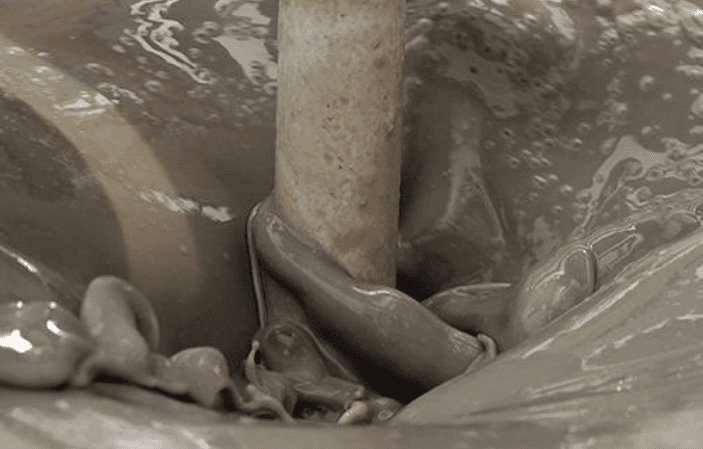Table of Contents

Drilling Fluid Types:
There are three basic categories of drilling fluid available today, namely water-based drilling fluid, oil-based drilling fluid and gas-based drilling fluid. Non-excavation drilling fluid typically uses water as its base material.
Water-based drilling fluid utilizes water as its dispersant medium, with clay, water and chemical additives as its key ingredients.
Based on our current drilling machine capabilities and China’s geological conditions, Neptune chemical drilling mud and components of chemical treatment agents were chosen.
Composition of Drilling Fluid
Clay (Bentonite)
Horizontal directional drilling mud contains clay mineral particles smaller than 2 microns in size that contain silica, alumina, water and small amounts of iron, and alkali metals(such as manganese). Their chemical makeup is known as hydrated aluminum silicate while their chemical makeup consists of hydrated aluminum silicate. Of all known types of clay minerals for drilling mud processes only four types are common and essential: Kaolinite Illite Montmorillonite Halloysite which are all known by this name).
Bentonite clay used by horizontal directional drilling mud is bentonite which is also known as clay).
Chemical Treatment Agents
To maintain the stability and enhance various process performances of horizontal directional drilling mud, numerous chemical treatment agents (drilling fluid additives) are added to it.
Horizontal directional drilling mud commonly requires chemical additives (drilling mud additives):
A. Common examples are pure alkali (Soda);
B. Collapse prevention agents
C. Filtration loss reducers;
D. Flocculants;
E. Lubricants and
F. Viscosity enhancers.
Drilling Fluid Main functions
Drill cuttings need to be carried and suspended in a way that keeps holes clean for continued drilling operations. Drilling mud serves this function by transporting away rock fragments broken by the drill bit (reamer) from within holes and keeping them free of dirt or soil debris that enters through them, thus keeping holes unclogged and clean.
Stabilize the borehole wall. A stable and regular borehole wall is essential to fast, quality drilling and is the starting point for effective mud technologies measures.
Cool and flush the drill bit as well as clean rock (or soil) cuttings from the hole, while adjusting the weight of drilling mud within a wide range to create a liquid column pressure which aligns with formation pressure, thus avoiding leakage, collapses, or sticking issues.
As a general guideline, when selecting drilling fluid for each phase, structure or measure in drilling, its selection should depend on geological considerations to achieve quality and speedy drilling. To do so, appropriate measurements for its use must also be determined to meet this goal.
Drilling Fluid Use and Mixing Procedure
Chemical treatment agents commonly used as drilling mud additives in horizontal directional drilling mud include:
A. Pure Alkali (Soda): Sodium carbonate, commonly referred to as soda ash. Pure alkali dissolves easily in water and hydrolyses in response to chemical processes; when mixed, it significantly improves water dispersion properties in clay, helping it bind moisture efficiently within its cells and decrease water loss while increasing viscosity and shear force in mud systems. Therefore, adding an appropriate amount of pure alkali may reduce fluid’s water loss while increasing viscosity and shear force simultaneously.
B. Collapse Prevention Agents: Main components include potassium humate, asphalt powder, sulfonated asphalt powder, sulfonated phenolic resin and coal alkali solution. Asphalt powder in particular serves multiple functions, increasing lubricity while simultaneously preventing sticking, blocking porosity in mud cake layers and adjusting adhesive force between solid particles thereby decreasing filtration loss and preventing collapse.
C. Filtration Loss Reducers: Our filter loss reducers include sodium carboxymethyl cellulose (Na-CMC) and polyacrylonitrile, while polyacrylamide (PAM) serves three major purposes – flocculation, collapse prevention and shearing.
D. Flocculants: Our polymers include Na-CMC and PA in China.
E. Lubricants: In horizontal directional drilling, extreme-pressure lubricants like stearate esters and sulfonated asphalts are utilized. Since hydrophilic groups on these molecules bind with metal surfaces or clays and form a chemical film layer that forms friction with oil-loving groups on them, improving drilling mud lubricity while simultaneously decreasing friction levels and preventing adhesive sticking of the drill bit.
Drilling Fluid Formula 1: For Clay
Geological characteristics of clay layers encompass coarse soil with loose geological structures. This includes alluvial sand soil, backfill soil, silty sand, and mud. Fine soil structures tend to be harder, exhibiting strong water absorption capabilities. Yellow and brown mudstone stand out as notable examples.
The main features of clay layers are their excellent pore formation and drillability. Drilling tools can rotate, incline, and emerge from the soil seamlessly, ensuring the creation of stable holes. This makes clay layers the ideal strata for traversal.
Composition of Clay Layer Drilling Fluid:
Bentonite + Pure Alkali + Filtration Loss Reducer + Lubricant, mixed at 1 kg/m3, will yield the following ratio (Kg/m3).
Drilling Fluid Formula 2: For Sand
Composition of drilling mud for drilling in layers with fine sand, pebbles, and gravel (in small quantities):
Geological features of sand layers: Clay-rich or silty soil mixed with large quantities of yellow sand that contains pebbles and gravel are characteristic features.
Main characteristics: Average pore-forming properties, easy water loss and strong absorption properties make the fluid average in terms of its properties; collapse-prone during directional drilling/reaming is very likely. Sand content causes repeated crushing of rock fragments by machinery causing heavy wear on tools/equipment and leading to heavy wear over time. Composition of Drilling Fluid:
Bentonite (high content) + Collapse Prevention Agent (polymer, appropriate concentration) + Lubricant, Mixing Ratio of (Kg/m3): 1:1:0.05:0.06